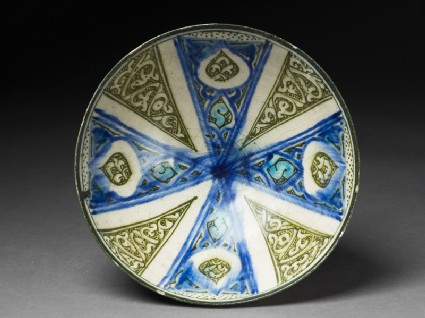Search Results: objects
Show search help- Reference URL
Actions
Bowl with radial design and drop-shaped cartouches
-
Details
- Associated place
- Date
-
late 13th century - 14th century
Ilkhanid Period (1256 - 1353)
- Material and technique
- fritware, with underglaze painting in blue and black
- Dimensions
-
10.5 cm (height)
21.6 cm (diameter)
- Material index
- Technique index
- Object type index
- No. of items
- 1
- Credit line
- Gift of Gerald Reitlinger, 1978.
- Accession no.
- EA1978.1638
-
Further reading
Allan, James W., Islamic Ceramics, Ashmolean-Christie's Handbooks (Oxford: Ashmolean Museum, 1991), no. 17 on p. 32, illus. p. 32
Glossary (2)
fritware, underglaze painting
-
fritware
Ceramic material composed of ground quartz and small quantities of clay and finely ground frit (frit is obtained by pouring molten glass into water).
-
underglaze painting
Painting applied to ceramic material before a transparent, or monochrome or coloured glaze for Islamic objects, is applied. The technique was initially developed in China.
Location
-
- currently in research collection
Objects are sometimes moved to a different location. Our object location data is usually updated on a monthly basis. Contact the Jameel Study Centre if you are planning to visit the museum to see a particular object on display, or would like to arrange an appointment to see an object in our reserve collections.
Publications online
-

Islamic Ceramics
The underglaze painting tradition, once developed, was to have continuing use in Islamic ceramics, and changes in style and colour scheme mark successive phases. Under the Il-Khanid (Mongol) rulers of Iran in the late thirteenth century the style of vegetal design becomes looser and more fluid, the variable but distinct background pattern of the pre-Mongol period become loose groupings of dots, and the black becomes much softer and greener in colour. Occasional blobs of turquoise indicate an interest in expanding the underglaze palette. Figural decoration declines, and the commonest designs are now geometric, with a variety of arabesque patterns used as fillers. Both these bowls have radial designs. No. 17 [EA1978.1683] has a ‘Maltese’ cross which is emphasised visually by its colour, by its wide, white border, and by the wide, white surround to the pear-shaped cartouches in each of its arms. In no.18 [EA1978.1595] the centre has a greater emphasis, and the balance of the now eight radiating panels is more subtle. The primary cross-shape is emphasised by its pointed arms, and by the use of the same arabesque design as a filler for each of them. The four secondary arms have square ends and the designs used as fillers alternate, two and two. The result is that although the bowl is decorated with an eight-point radial design, the eye reads it as a cross.
© 2013 University of Oxford - Ashmolean Museum



